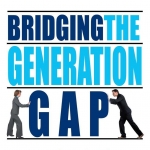Communication is Key in Age-Based Conflicts
If it were an illness, it would be an epidemic. If it were a storm, it would be a tsunami. If it were a flood, we would be building an ark. Today, ten thousand baby boomers will turn sixty-five. Another ten thousand will cross the line tomorrow, and the trend will continue every single day until the year 2030. The graying of America comes in more than fifty shades.
Experts disagree on what effect an older America will have on the individual, but the trends for society are already beginning to emerge. When each generation recognizes the strength and value that can be found in different life experiences, a shared vision can result.
Business Adapts
For perhaps the first time in American history, five generations work side-by-side in the marketplace.
For perhaps the first time in American history, five generations work side-by-side in the marketplace. Though the names and dates may vary a little, the generations include the Radio Babies, or Veterans; Baby Boomers; Gen Xers; Gen Yers; and Millennials. Sociologists and researchers affirm that the differences in how various age groups approach work are becoming more distinct and dangerous.
In their book, Bridging the Generation Gap: How to Get Radio Babies, Boomers, Gen Xers, and Gen Yers to Work Together and Achieve More, authors Linda Gravett and Robin Throckmorton offer this observation. “Miscommunication and conflict across generations affects productivity, morale, and customer satisfaction. We must do better if we want our organizations to survive and thrive.” The book leads members of any generation to see how they can relate with other age groups in a way that minimizes conflict and miscommunication.
Robin Throckmorton is a passionate communicator. She is the president of strategic HR, inc., an organization that has provided Human Resources and related information and services to the Cincinnati area for more than 20 years. Strategic HR, inc. believes the communication that comes through Human Resources plays a significant role in blending the generations in the workplace.
Throckmorton says that often “personality allows for the acceptance to change” and minimizes conflict. Which generations have the toughest time getting along? Probably the Baby Boomers and the Millennials. Boomers critique that the Millennials are easily distracted, lack discipline and focus, and are not teachable. Millennials counter that the Boomers can be sexist, racist, insensitive, unwilling to change and lack creativity.
While it is natural to focus on differences, common threads of the need for team interaction and personal security should be emphasized. The Millennials understand and desire to be guided and coached, a role the Boomers could easily fill. Throckmorton notes that to be effective, the Boomers need to stop “trying to teach everyone how to be like us,” and instead share lessons from experience for the Millennials to apply to their own lives.
Families Adjust
The landscape of the American family is not only changing by the definition of marriage and family, but by the people who are traditionally occupying the family home. More than four in ten Gen Yers have never stopped living with their parents or have returned home due to unforeseen circumstances. In addition, many Boomers and Gen Xers are now caring for their aging Radio Baby parents in their homes or are making caregiving choices about specific care facilities. Either alternative comes with enormous challenges and opportunities for miscommunication.
For multiple generations living under the same roof, Throckmorton emphasizes “establishing clear boundaries” for space and behavior, as well as constant communication about expectations and information. Planning activities that include both younger and older adults teaches children respect and attention to elders. Family counselors encourage families to engage in storytelling, where every day one person shares a story. Storytelling provides everyone the chance to communicate and share in the events that have shaped their lives.
Economic insecurity can be a thread that binds most of the generations. The boomers have simply not saved enough for retirement, and the Gen Yers have lower incomes, less wealth, higher unemployment and greater debt than any other generation at the same stage of life. The upcoming Millennials are at risk of having even a lower standard of living than their parents.
Communicate Respect
When asked what advice could be offered to assist in understanding and bridging the gaps between the generations, Throckmorton did not pause before responding with one word, “Respect.”
She says we need to “respect other generations for what they bring to the table. While we accept that there may be differences, we also accept that there is much to be gained through the diversity.”
Developing any kind of relationship takes time and effort. Nebulous expectations can make each generation feel uncomfortable and insecure. Younger people may feel they have nothing in common with the aging, while it takes seniors time to adapt to the energy and volume of their younger family members. With time and effort, relationships will grow and mature as both the young and the old work together to bridge generational barriers.



